#ediacaran era
Explore tagged Tumblr posts
Text
Time Travel Question 48: Early Modernish and Earlier 3
These Questions are the result of suggestions a the previous iteration.This category may include suggestions made too late to fall into the correct earlier time grouping. In some cases a culture lasted a really long time and I grouped them by whether it was likely the later or earlier grouping made the most sense with the information I had. (Invention ofs tend to fall in an earlier grouping if it's still open. Ones that imply height of or just before something tend to get grouped later, but not always. Sometimes I'll split two different things from the same culture into different polls because they involve separate research goals or the like).
Please add new suggestions below if you have them for future consideration. All cultures and time periods welcome.
#Time Travel#Paracelsus#Early Modern#Precolonization#Indigenous Cultures#Aphra Behn#Il Sodoma#Art History#Theater History#Espionage#The Man in the Iron Mask#Yellowstone#Indigenous History#18th Century#17th Century#Serial Killer#Nursery Rhymes#Nanny of the Maroons#Escaped Slaves#Jamaica#1600s#1700s#Caribbean History#Black Women's History#Black History#Women's History#Ediacaran Era#Neoproterozoic Era#Ancient Iberian Cultures#Iberian History
61 notes
·
View notes
Text

doodle page 1
17 notes
·
View notes
Text


What a wonderful thing to travel to the edges of time and a little after the birth of life. I just want to see a bit of the ediacaran era and all the way up to the end of the Paleozoic up to the Permian.
Currently obsessed with the time right after the precambrian period and before those little guys existed in the Cambrian right after life began being multicellular. What a wonderful world
2 notes
·
View notes
Link
SpaceTime Series 27 Episode 119 *Australian Crater Offers Fresh Insights into Earth's History Scientists have uncovered a potential 600-kilometre-wide crater in Australia's outback, which could revolutionise our understanding of Earth's geological past. This discovery, presented at the 37th International Geological Congress in South Korea, suggests the existence of Mapix, a massive Cambrian-Precambrian impact structure. The crater's unique characteristics could provide new insights into the geological and biological evolution of our planet. The study's authors have found significant geological evidence, including pseudotachylite breccia and shock minerals like lonsdaleite, supporting the age, size, and location of this impact structure. *Perseverance Rover Discovers Striped Rock on Mars NASA's Mars Perseverance rover has spotted an unusual black and white striped rock on the Red Planet. The discovery was made during the rover's exploration of the outer rim of Jezero Crater. The rock, named Freya Castle, has a striking pattern and is unlike anything previously observed on Mars. Early interpretations suggest that igneous and metamorphic processes could have created its distinctive stripes. This finding adds to the variety of intriguing rocks discovered by the rover, which could be among the oldest or youngest ever investigated on Mars. *Blue Origin's New Glenn Completes Second Stage Hot Fire Test Blue Origin's new heavy-lift rocket, the New Glenn, has successfully completed a hot fire test of its second stage booster. This critical test at Cape Canaveral's Space Launch Complex 36 marks a key step towards the rocket's inaugural test flight, scheduled for next month. The NG-1 mission will carry the prototype Blue Ring spacecraft, designed for refuelling, transporting, and hosting satellites. The 15-second hot fire test demonstrated the integrated operation of the vehicle's BE-3U engines and various subsystems, setting the stage for future missions. www.spacetimewithstuartgary.com www.bitesz.com 🌏 Get Our Exclusive NordVPN deal here ➼ www.bitesz.com/nordvpn. The discount and bonuses are incredible! And it’s risk-free with Nord’s 30-day money-back guarantee! ✌ Check out our newest sponsor - Old Glory - Iconic Music and Sports Merch. Well worth a look.... Become a supporter of this podcast and access commercial-free episodes plus bonuses: https://www.spreaker.com/podcast/spacetime-with-stuart-gary--2458531/support. 00:00 - This is spacetime series 27 episode 119 for broadcast on 2 October 2024 00:49 - Scientists have discovered a possible crater stretching more than 600 kilometres across Australia's outback 02:54 - NASA's Mars Perseverance rover has discovered an unusual striped rock 05:46 - The Mars Perseverance rover is exploring ancient Martian rocks 10:59 - Researchers have found nanostructures around deep ocean hydrothermal vents 12:57 - 61% of Americans admit to self censoring, according to study 15:09 - Meta showing off their new Orion augmented reality glasses; Huawei releasing threefold phones 19:16 - Spacetime is available every Monday, Wednesday and Friday through various podcasting services
#australian-crater#blue-origin#breccia#cambrian-precambrian-impact#commonwealth#crater#deposits#ediacaran-period#geological-history#iridium#jezero#kodiak-buddy#lonsdaleite#mars-perseverance-rover#neoproterozoic-era#new-glenn#pseudotachylite#striped-rock-on-mars#university#virginia
0 notes
Text
TOP TEN DINOSAURUSES
maybe you're wondering my most tenned favorite dinosauruses??? The science study of dinasacacers is called "dinosaurusology" by leading experts like myself, and it is constantly changing as we make new uncoveries almost every tuesday when we find new bones in my cousin rob's garage (he hasn't thrown anything out since the 90's!) As such bear in mind that up to two facts I am about to share could become dated over the course of the next century, however as both the king and queen of science this will only be true if I'm still available to approve the new facts. If I'm dead or kind of tired then nobody will ever know what's true anymore so you should be nice to me. #10: OVIRAPTOR
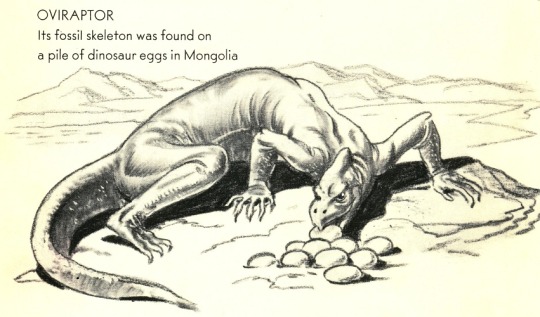
OVIRAPTOR was a good model for what all dinosacans were like: it was a wrinkly lizard that slithered in filthy dirt and had difficulty standing upright because its bones were made of rocks. This is why we have the term "the stone age," so be grateful you're living in "the bone age!" Oviraptor's name means "eggs velociraptor" because it was a kind of velociraptor that stole eggs. It didn't know what to do with them because nobody invented cooking yet and raw dinosaur eggs were disgusting, so every oviraptor starved to death.
#9: IGUANADON
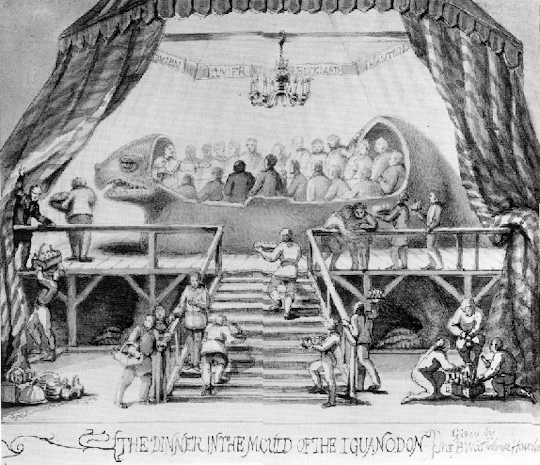
This was the last known photograph of IGUANA DON (not to be confused with his cousin iguana dan) when george washington invented photographs 2 million years ago. Don was an ugly disgusting hilarious lizard monster with one horn on its nose and he died because he evolved a dining room in his torso exactly the right size for 21 cavemen to walk in and eat his kidneys. This was not helped by don's instinct to sleep on a big porch under a chandelier.
#9 DIMETRODON
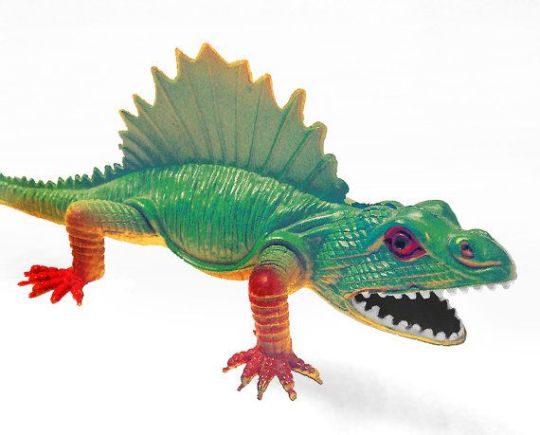
DIMETRODON was the most common dinosaur of jurassic, which was the fifth and final era of dinosaurs after the ice age but before the ediacaran. In fact dimetrodon was the very last dinosaur to ever exist on earth before they were all eaten to death by the ediacaran's dominant predator: a species of swirly looking weird rock. Nobody knows why these swirly looking weird rocks died out, but it's most likely because dimetrodon was so poisonous from its diet of entirely pufferfish. You can tell it was a sea dinosaur because of its fish fin! #8: PTERADACTYL
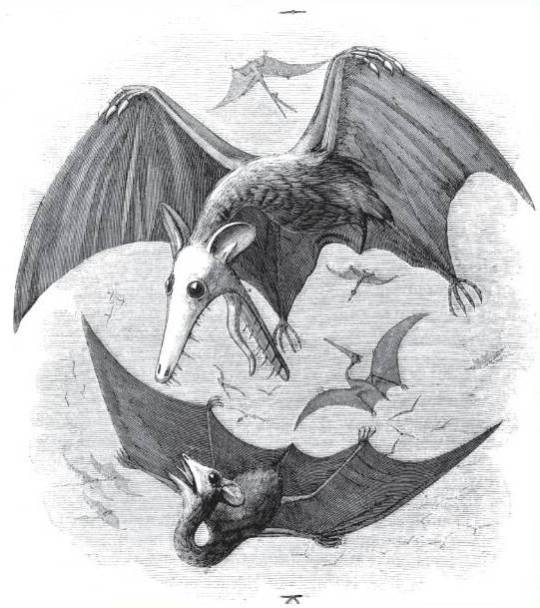
PTERODACTYL was a regular dinosaur until it got married to a species of bat and its bat wife laid a bunch of pterodactyl eggs! This woodcut is however inaccurate: flying would not be invented until president obama discovered the first airplane in 1998, so pterodactyl couldn't possibly have stayed in the air and just immediately fell. The long 900 million year reign of the pterodactyl abruptly ended when the last one finally hit the ground (it took longer in those days because the oxygen disaster made so much more air) #7 SNORKASAURUS
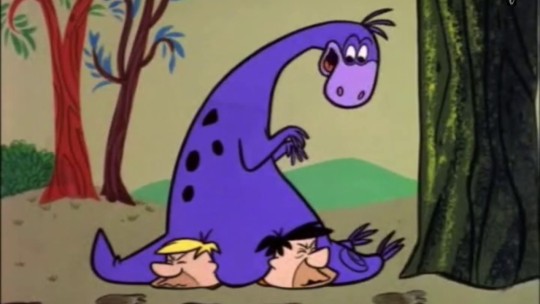
SNORKASAURUS was completely unique among all dinocaurs by having a really long neck. It was one of the largest creatures to ever roam the earth at over 7 feet tall, or exactly 12 meters to those of you living in Liberia or Myanmar! This is the last known photograph of snorkasaurus, giving birth to the first cavemen. Snorkasaurus went extinct because all of them did this instead of making baby snorkasauruses. This is because like all dinosaurii they had only a tiny peanut for a brain, and nobody was around to give them 'the talk' because that wasn't invented yet.
#6 SMILODON
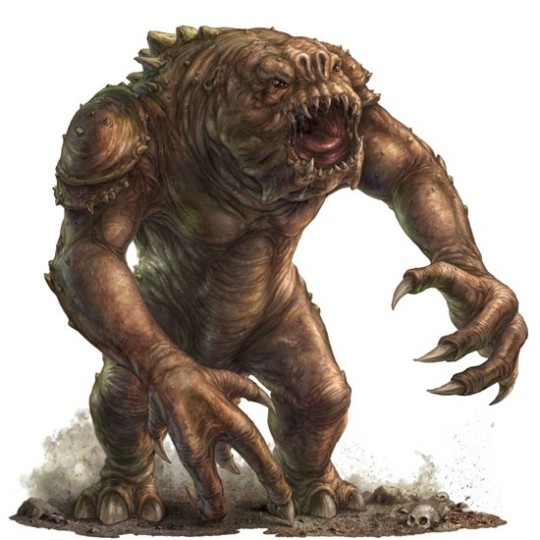
SMILODON was a very special dinosaurn because it was the first one to stand up on its hind legs after years of rigorous exercise and weight training. By inventing this new way of walking, Smilodon made it possible for the first monkeys to evolve! This is called "convergent" evolution.
#5 BULBASAUR
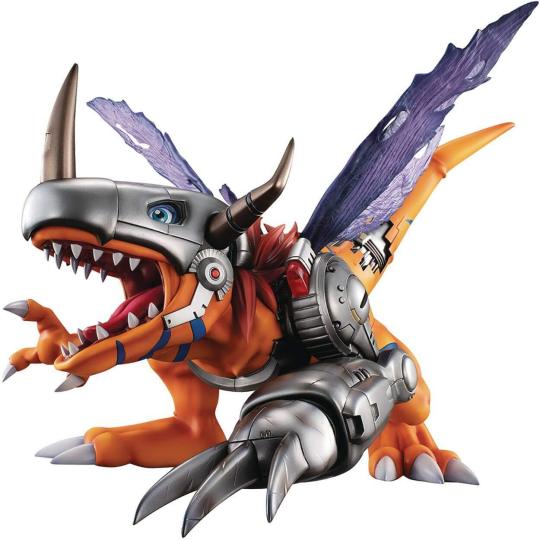
BULBASAUR was a majestic and beautiful species of neopet unfortunately disliked by the scientific community because it is the reason there are no flying dinosuars. Bulbasaur was the first ever flying dyanasar ever invented, 19 billion years ago on September 10, 2001, but the project was discontinued when its first test flight ended in a tragic accident. That's right: on September 11, 2001, Bulbasaur crashed into the stock market, causing the great depression that lead to the civil war :'( now to this very day, flying dinosarers are against the law.
#4 YOSHI

YOSHI is a type of dinersaulophus called a "bird," which was actually the second attempt by early neanderthal alchemists to manufacture a street legal flying dinnersauran, but the New Zealand government realized if dinophlofbuses can fly, then bats would no longer be special, and since bats are New Zealand's only major export it would have been an economic disaster. The queen of Australia (New Zealand's largest city) ordered the CIA to sand all of the wings off of these early prototype birds. Every bird tragically went extinct when it looked down, noticed how high up it was and remembered it could not fly, activating the effects of Earth's gravitational field.
#3 ANOMALOCARIS

ANOMALOCARIS was the dinosorcerous that discovered the first primitive cave painting of a modern day crab and invented carcinisation. All the other dinanders laughed at Anomalocaris for wanting to turn into a crab, but guess what??? Every single kind of dinosaur is dead but there's a crab still alive at 29, making it the oldest person in the world. Who's FUCKING laughing now!!!!!!!!!!!!!!!!!!
#2 EARL SINCLAIR

This is the last known photograph of Earl Sinclair, seen here as an uncredited extra in "Avatar 3: Lost in New York." Earl Sinclair was a sindonaur species that could disguise itself as a human by putting on sunglasses, a necessary adaptation in order to hide from the largest predator dancasore to ever live: Mellisuga helenae. However, near the end of the coal age, M. Helenae finally remembered that sunglasses hadn't even been invented yet. Look carefully, and you'll notice nobody is wearing sunglasses at all in this scene, making Earl Sinclair stick out like a sore thumb! If you're still having difficulty, here's a zoomed in image of this majestic thunder lizard:

Unfortunately......this wardrobe malfunction made Mr. Sinclair just as obvious to his ancient enemy, and the last Earl Sinclair's brains were sucked out on September 11, 2001, the darkest day in British history because he was the only one who knew the recipe to chicken mcnuggets (the only british food.) To this day all british people are extinct but you can still see their fossilized skeletons waiting in line at the department of motor vehicles.
#1 CONCAVENATOR
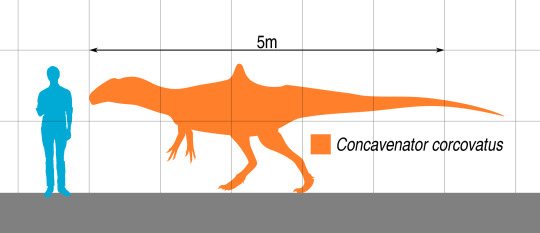
Concavenator was an Early Cretaceous carcharodontosaurid up to six meters in length with an unusual pointed crest on its back.
#science#dinosaurs#paleobiology#paleoart#nature#animals#lizards#reptiles#birds#ADAD don't get mad at me I actually hope if you ever see this you just find it cute and enjoy the convoluted references I put in
3K notes
·
View notes
Text
Round 1 - Phylum Arthropoda
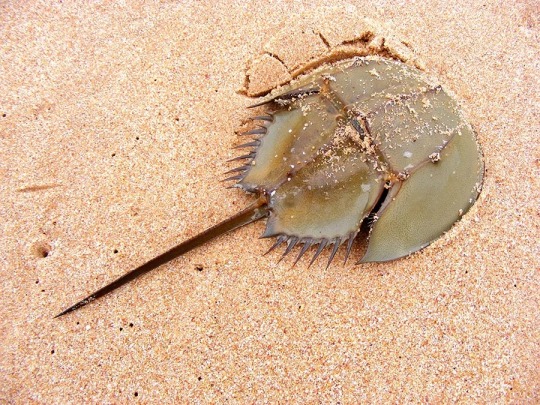
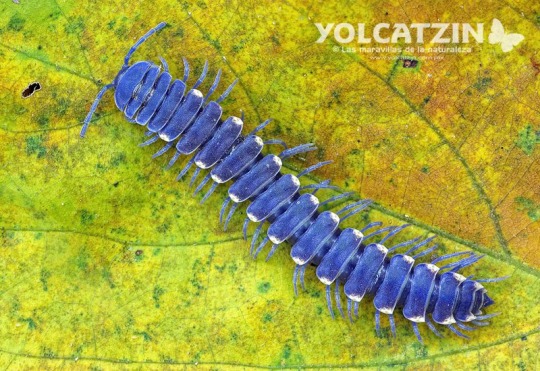
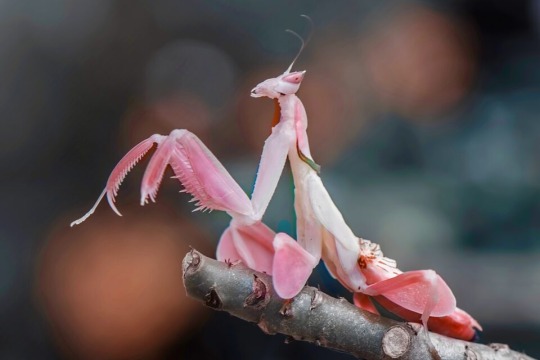
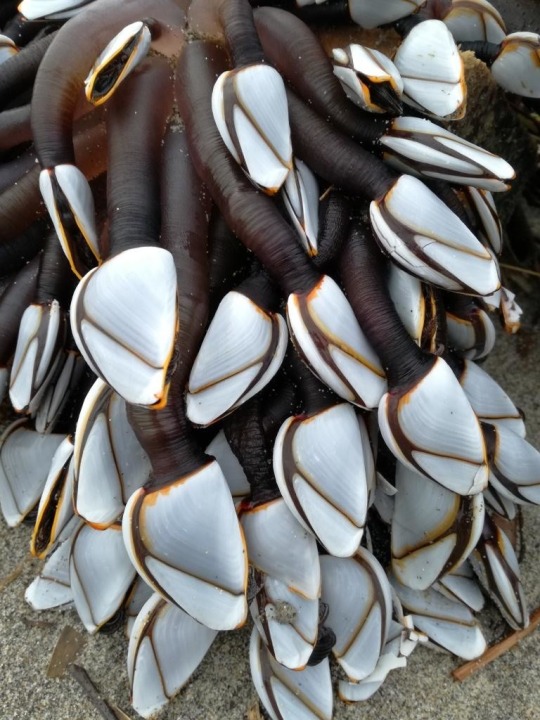
(Sources - 1, 2, 3, 4)
Arthropoda is a phylum of animals that have segmented bodies, possess a chitin exoskeleton, and have paired segmented appendages. They are colloquially called “bugs” though this is often only used for terrestrial arthropods, and sometimes only used for insects specifically.
After Nematoda, this is the most successful phylum, and it is far more diverse, with up to 10 million species! Arthropods account for 80% of all known living animal species. The three major subphyla include the Chelicerates (sea spiders, horseshoe crabs, arachnids, and the extinct eurypterids and chasmataspidids), the Myriapods (centipedes and millipedes), and the Crustaceans (shrimps, prawns, crabs, lobsters, crayfish, seed shrimp, branchiopods, fish lice, krill, remipedes, isopods, barnacles, copepods, opossum shrimps, amphipods, mantis shrimp, entognaths, and insects).
Arthropods are so diverse in fact that it is next to impossible for me to describe a model arthropod. They are important members of marine, freshwater, land, and air ecosystems and are one of only two major animal groups that have adapted to life in dry environments, the others being chordates. All arthropods have an exoskeleton and must molt as they grow, replacing their exoskeleton. Some arthropods go through a metamorphosis in this process. They have brains, a heart, and blood (called hemolymph, though some crustaceans and insects also use hemoglobin). They sense the world through small hairs called setae which are sensitive to vibration, air currents, and even chemicles in the air or water. Pressure sensors function similarly to eardrums. Antennae monitor humidity, moisture, temperature, sound, smell, and/or taste, depending on species. Most arthropods have sophisticated visual systems ranging from simple eyes (ocelli) which orient towards light, to compound eyes consisting of fifteen to several thousand independent ommatidia capable of forming images, detecting fast movement, or even seeing polarized or ultra-violet light. Some arthropods are hermaphroditic, some have more than two sexes, some reproduce by parthenogenesis, some by internal fertilization, some by external, some have complex courtship rituals, some lay eggs, some give live birth, some have prolonged maternal care. The first arthropods are known from the Ediacaran, before the Cambrian era.
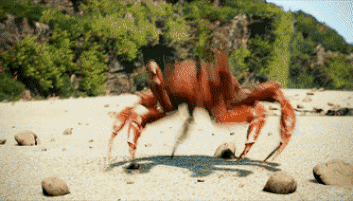
Propaganda below the cut:
Insects are the first animals to have achieved flight
The smallest arthropods are the parasitic crustaceans of the class Tantulocarida, some of which are less than 100 micrometres long. The largest arthropod is the Japanese Spider Crab (Macrocheira kaempferi) with a legspan of up to 4 metres (13 ft) long. The heaviest is the American Lobster (Homarus americanus), which can get up to 20 kilograms (44 lb).
Many arthropods are popular pets, including various species of crab, shrimp, isopod, crayfish, mantis shrimp, millipede, centipede, tarantula, true spider, scorpion, amblypygid, vinegaroon, mantis, cockroach, beetle, moth, and ant! Some are even domesticated, including silk moths and honeybees.
Many arthropods are eaten by humans as a delicacy, and farming insects for food is considered more sustainable than farming large chordates. These farmed arthropods are referred to as “minilivestock.”
Arthropods feature in a variety of ways in biomimicry: humans imitating elements of nature. For example, the cooling system of termite mounds has been imitated in architecture, and the internal structure of the dactyl clubs of mantis shrimp have been imitated to create more damage tolerant materials.
Spider venoms are being studied as a less harmful alternative to chemical pesticides, as they are deadly to insects but the great majority are harmless to vertebrates. They have also been studied and could have uses in treating cardiac arrhythmia, muscular dystrophy, glioma, Alzheimer's disease, strokes, and erectile dysfunction.
Shellac is a resin secreted by the female Lac Bug (Kerria lacca) on trees in the forests of India and Thailand. It is used as a brush-on colorant, food glaze, natural primer, sanding sealant, tannin-blocker, odour-blocker, stain, and high-gloss varnish. It was once used in electrical applications as an insulator, and was used to make phonograph and gramophone records until it was replaced by vinyl.
One of the biggest ecosystem services arthropods provide for humans is pollination. Crops where pollinator insects are essential include brazil nuts, cocoa beans, and fruits including kiwi, melons, and pumpkins. Crops where pollinator insects provide 40-90% of pollination include avocados, nuts like cashews and almonds, and fruits like apples, apricots, blueberries, cherries, mangoes, peaches, plums, pears, and raspberries. In crops where pollinators are not essential they still increase production and yield. Important pollinators include bees, flies, wasps, butterflies, and moths.
Many arthropods are sacred to humans. In Ancient Egypt, scarab beetles were used in art, religious ceremonies, and funerary practices, and were represented by the god Khepri. Bees supposedly grew from the tears of the sun god Ra, spilled across the desert sand. The goddess of healing venomous bites and stings, Serket, was depicted as a scorpion. Kalahari Desert's San People tell of a legendary hero, Mantis, who asked a bee to guide him to find the purpose of life. When the bee became weary from their search, he left the mantis on a floating flower, and planted a seed within him before passing from his exhaustion. The first human was born from this seed. In Akan folklore, the cunning trickster figure Anansi/Ananse is depicted as a spider. Western astrology uses the crab constellation, called Cancer, and the scorpion constellation, called Scorpio. Dragonflies symbolize pure water in Navajo tradition. In Anishinaabe culture, dreamcatchers are meant to represent spiderwebs and are used as a protective charm for infants. They originate from the Spider Grandmother, who takes care of the children and the people of the land in many Native American cultures. The Moche people of ancient Peru often depicted spiders and crabs in their art. In an Ancient Greek hymn, Eos, the goddess of the dawn, requests of Zeus to let her lover Tithonus live forever as an immortal. Tithonus became immortal, but not ageless, and eventually became so small, old, and shriveled that he turned into the first cicada. Another hymn sings of the Thriae, a trinity of Aegean bee nymphs. Native Athenians wore golden grasshopper brooches to symbolize that they were of pure, Athenian lineage. In an Ancient Sumerian poem, a fly helps the goddess Inanna when her husband Dumuzid is being chased by galla demons. In Japanese culture, butterflies carry many meanings, from being the souls of humans to symbols of youth to guides into the afterlife. Ancient Romans also believed that butterflies were the souls of the dead. Some of the Nagas of Manipur claim ancestry from a butterfly. Many cultures use the butterfly as a symbol of rebirth. And the list goes on…
cute crab eat a strawbebby:
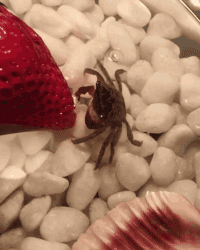
#round 1#animal polls#listen narrowing it down to just 4 images almost killed me#if arthropods don’t move on to round 2 I will have to take like an extra week off to mourn that I can’t show you all the cool bugs#there’s so many cool bugs guys#i chose the orchid mantis over a trilobite beetle and a poofy little bee fly cause I figured it had broader appeal#and used a horseshoe crab instead of a spider cause people are so Weird about spiders I worried it would impact the numbers#sigh#anyway I’m really hoping for Chordata Arthropoda Mollusca as top three#other phyla are all great but these three would make for the most interesting Round 2 imo
241 notes
·
View notes
Text

Here’s my best stab at a stromatolite! There’s many forms of stromatolites and internal structure patterns, I hope I did them justice.
Stromatolites are more a sedimentation structure as a result of a living thing, rather than a living thing themself. Cyanobacteria traps sediment into layers over time, resulting in a banded structure. They’re among the first signs of life on our planet and you can still find them being created today!
For the moment, I have them in my ediacaran group. Otherwise, I would technically have to give them a spot in every era of time!
Stickers || Phone Wallpapers Masterlist
58 notes
·
View notes
Text
fossil records suggest that the Ediacaran era may have been a "golden age" of yuri, with many different species of girl flourishing side by side in harmony
603 notes
·
View notes
Text
Strange Symmetries #03: Eerie Early Echinoderms
Represented today by starfish, brittle stars, sea urchins, sea cucumbers, and crinoids, the echinoderms have a characteristic five-way radial symmetry that makes them barely even recognizable as bilaterians. Their true ancestry is only revealed by their genetics and their larvae, which still retain bilateral symmetry – and the way they metamorphose into adults is bizarre, essentially growing a whole new radial body from within the left side of their larval body.
(Sea cucumbers and sand dollars are superficially bilateral as adults, but evolved this secondarily on top of their existing radial symmetry. And some adult echinoderms like starfish also seem to retain a little bit of "behavioral bilaterism", generally preferring to move with a specific arm always acting as their "front" end.)
The first known echinoderms appeared in the fossil record during the early Cambrian, about 525 million years ago, but the common ancestor of the whole group probably actually originated a few tens of millions of years earlier in the mid-to-late Ediacaran. Early echinoderms seem to have started off as flattened animals that sat on the seafloor filter-feeding, and with this largely immobile way of life their bodies started to shift into asymmetry, no longer constrained by the locomotory advantages of being bilaterally symmetric.
In fact, for these early sedentary filter-feeders being radial was actually much more advantageous, able to distribute sense organs all around their bodies and grab food from any direction without having to reposition themselves, converging on the lifestyle of non-bilaterian cnidarian polyps. The evolutionary transition from bilateral to asymmetrical to pentaradial seems to have happened incredibly quickly during the Cambrian Explosion, and all modern echinoderms probably evolved from a group called the edrioasteroids, maintaining their new base body plan even when they later began taking up more mobile lifestyles again.
But during the process of all that some very alien-looking lineages split off at various stages of anatomical weirdness.
Stylophorans had asymmetrical bodies with a single feeding arm at the front, and varied from irregular boot-like shapes to almost bilateral heart shapes depending on their specific ecologies. The highly asymmetrical forms were probably spreading their weight out over soft soupy mud in quiet waters, while the more bilateral forms may have been more streamlined to deal with stronger water currents.
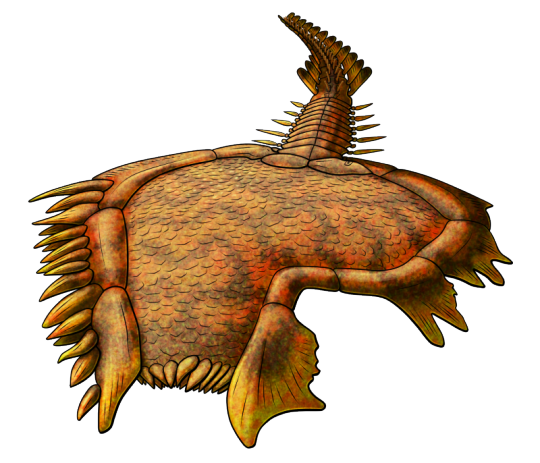
Sokkaejaecystis serrata was a stylophoran that lived during the late Cambrian, about 501-488 million years ago, in what is now South Korea. It was tiny, only about 1cm long (~0.4"), and its boot-shaped body was surrounded by spines and flanges that spread out its surface area and probably also made it much more awkward for small predators to attempt to eat.
———
Meanwhile the solutes started off as immobile animals living attached to the seafloor via a stalk-like appendage. But fairly early in their evolution they switched to a more active mode of life, modifying their stems into tail-like "steles" that were used to push themselves along.
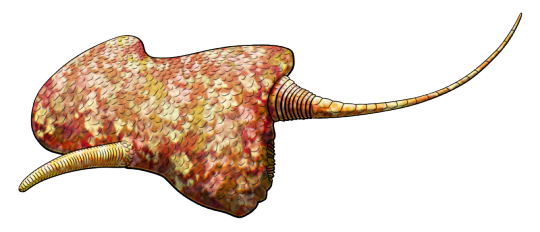
Maennilia estonica lived in what is now Estonia during the late Ordovician, about 450 million years ago. It was quite large for a solute at about 12cm long (~4.7"), with a sort of vaguely-trapezoidal body, a short feeding arm, and a long thin stele.
Both of these strange early echinoderm lineages were surprisingly successful, surviving for a good chunk of the Paleozoic Era alongside their more familiar radial relatives. The solutes lasted until the early Devonian about 400 million years ago, and the stylophorans continued all the way into the late Carboniferous about 310 million years ago.
———
NixIllustration.com | Tumblr | Twitter | Patreon
#science illustration#strange symmetries#paleontology#paleoart#palaeoblr#sokkaejaecystis#stylophora#maennilia#soluta#echinoderm#ambulacraria#deuterostome#bilateria#art#eldritch echinoderms#go home evolution you're drunk
508 notes
·
View notes
Text
Monday Musings: Why was the Cambrian Explosion possible?
Hello everyone! Did you miss me? Field season was wild but now I'm back and ready to talk more about rocks and fossils!
The Cambrian Explosion happened when marine life radiated rapidly into most of the basic body forms that we observe in modern groups today.

What made the Cambrian Period the ideal time and place for such an evolutionary burst? To get the answers, we need to go back in time just before the Paleozoic Era began.

Welcome to the Ediacaran Period, 600 million years ago. All of the continents were joined together to the form the supercontinent...Pannotia. You thought I was going to say Pangea, didn't you?

Pangea came much later. Pannotia sat on the south pole and it had a pretty massive ice cap on it. Of course, that was nothing compared to the snowball Earth o the previous period. The oceans were much cooler in this time and just like cold oceans today, it could have been the ideal breeding ground for plankton as cold water brings nutrients to the surface.

As the Ediacaran came to an end and the Cambrian began, the ice cap melted, the seas warmed up and the Pannotia began to break up.

One large continent, Gondwana, stayed at the south pole but several island continents moved toward the equator. The placements of the continents was critical to the evolutionary explosion.
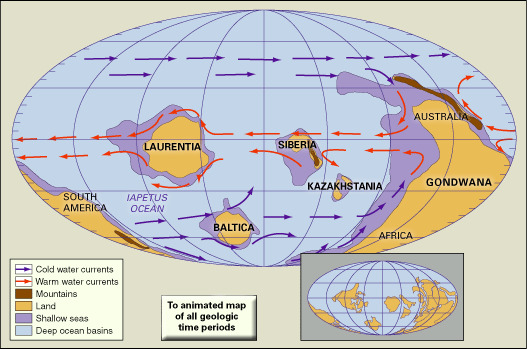
Ocean currents have a huge impact on climate. If we look at this map of the Cambrian world and its ocean currents, you can see the cold currents at the mid-latitudes and poles heading to the equator where they warm up and go back to the poles to cool down.

Now, if I plug in all our important Cambrian fossil sites you'll see that a vast majority fall on or very near the equator. An increase in warm ocean water and a rise in oxygen brought on by melting ice were probably two big parts in the rise of living organisms. Cold water brings nutrients up and is circulated by ocean currents. Warm water facilitates the production of carbonates like limestone and calcite for living things like echinoderms and arthropods.
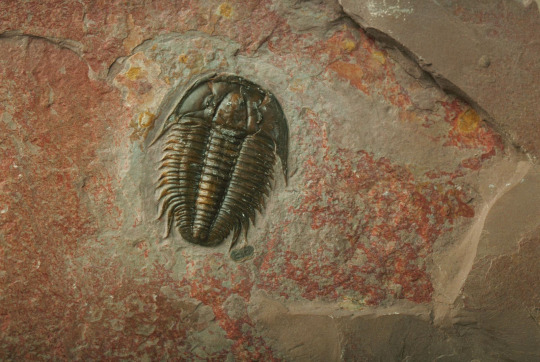
#paleontology#fossils#geology#mineralogy#deep time#cambrian period#cambrian explosion#paleoclimate#ocean currents
19 notes
·
View notes
Text
Almud Masterpost
Seemed like a good idea to create a place to compile information about the main planet project I have going.
Most of the pictures here are hand-drawn. I have slowly been improving at digital art, so I do intend on gradually replacing them with procreate recreations, but until then, have these messy pencil illustrations.

The planet’s name is Almud (pronounced “awl-MOO-duh” (yes, the D at the end is its own syllable)). It is the second planet from its star, an orange dwarf. Conditionswise, Almud is very similar to Earth, just a lot warmer and wetter, and without a single large moon. Instead, it has a somewhat recently-formed system of rings. These rings are made of the debris from the planet’s former moon, which floated in past the Roche limit a few dozen million years ago and got torn apart. Almud may or may not also have a smaller moon or two somewhere further out. I haven’t decided on that yet.

This is a map of Almud’s entire geography, which is slightly outdated. I’ll probably make an updated version at some point eventually possibly maybe. If you’re curious, those numbers on the continents were so I could keep track of continental drift to make sure everything made sense. I care way too much about tiny details.

This is a rough (and I mean very rough. Not proud of my craftsmanship on the outlines here) approximation of what Almud’s surface looks like. The foliage uses a teal pigment to photosynthesize, and the sky appears pink during the day. Obviously, not all of the planet is wetlands, but there are definitely more wetlands than there are on Earth thanks to the much higher humidity.
I have spent a lot of time trying to figure out what Almud’s animal-equivalent life should be like. After several failed attempts, however, I think I have gotten it to a point I am satisfied with. Below is a phylogenetic tree of all of the “animal” phyla present on Almud, and an overview of what each phylum has going on. I tried not to rip off Earth's phylogeny too much, but there are some notable parallels.

Vaxistoma (roughly "vaccine mouth"): Small fishlike creatures that feed through a proboscis with an extendible needle-tooth-thing inside of it. The rest of their body is covered in thick, hard scales. They mainly inhabit deeper waters where aquatic duossei are less common.
Duosseus ("two skeletons"): The closest equivalent to vertebrates. First members were fishlike, with calcified plates covering the outside of their bodies and rod-shaped bones supporting the inside. The outer skeleton atrophied mostly in the terrestrial members, but most classes do still have notable remnants, as shown in the small drawing above.
Limosus ("muddy, slimy things"): Soft, squishy creatures without much in terms of an internal skeleton, but most groups do have some external armor like their relatives listed above. Can be accurately summarized as "molluscs, but more alieny", though a few members are more like worms or sea stars.
Jocomodivirae (very roughly "funny little guys"): Small velvet worm-esque invertebrates with a thick, leathery pad over their back. A very diverse phylum with many, many members. Definitely not just insects with no exoskeletons.
Planagelattae ("flat jellies"): What if flatworms had three eyes?
Xenigmalus ("strange, mysterious things"): I can't think of a good way of describing these, which is pretty fitting for what they are. Body plans vary wildly here, but are almost always some combination of fins, tentacles, and a big translucent sack. Like the vaxistomans, they usually inhabit deeper waters.
Cornivermia ("horned worms"): Pretty self-explanatory. The flat, hard bits at the fronts of their heads help them dig through softer areas of soil. Some groups use these growths instead as something more akin to pincers, fins, hooks, or shells.
Carniherbae ("meat plants"): You know those animal-fern things from the Ediacaran era? These are just those, but not extinct.
Vivitria ("living glass"): Soft, feathery insides protected by a crystalline silicate shell. Many species in this phylum are colonial, which tend to look like colorful, floating geodes. These colonies often have surprisingly complex sensory capabilities, and some have been found to be about as intelligent as Earth cats.
Xylovitria ("wood glass"): Terrestrial relatives of the vivitrians, almost all of which are colonial. The defining feature of this phylum, besides their terrestriality, is their symbiotic relationship with a wide range of plant-equivalent species. The xylovitrian colony forms a protective, glassy wall around the plants' branches, as well as a system of feathery roots beneath the soil which serve to both gather nutrients for their plant partner and exchange gametes with other colonies to create new, empty xylovitrians for the plants' seeds to land in. In return, the plant gives the colony some of the byproducts of its photosynthesis.
Chiforma ("X-shaped"): Four-sided radially symmetrical creatures. Contains such captivatingly creative groups such as "squids, but four", "clams, but four", "eels, but four", and, most creataculiciously of all, "coral, but four". A shining example of the innovation that specbio nerds are capable of.
Nodovellis ("tangled hair"): Formless, sessile filter feeders. Basically a slime mold trying really hard to be a sponge, but the closest it could get was becoming a loofah.
(Feel free to give critiques or advice on the scientific names I made. All I really did here was mess around with google translate. I know there are guidelines and policies for what is and isn't an acceptable phylum title, but I've never been able to understand what any of them mean. If anything immediately makes you go "That's not how that works!", let me know)
For some additional information, I imagine that life on Almud began in freshwater rather than saltwater. This made the transition to land pretty easy for most of the animals, since they could afford to just flop around in muddy wetlands without any risk of drying out. This does mean that their skin is very, very sensitive to salt, however.
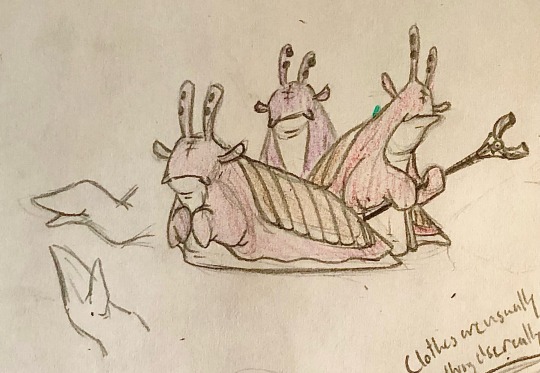
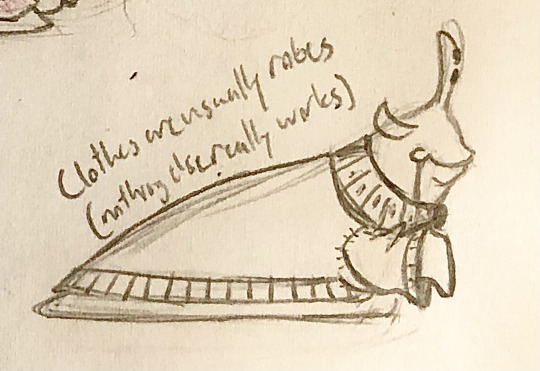
There is one sapient species on Almud: These slug things. Their actual species name is Akada, if that's important. Akada are descended from a social burrowing species that learned how to cultivate the many plants and molds that thrived in the dark, wet conditions of their tunnels. They are herbivorous, have a herd animal-like social structure, and currently have a level of technological advancement similar to ours. For more miscellaneous and mostly jokey info on them, please look here.
I will expand on all of this when/if I find the time and motivation.
#art#pencil on paper#alien#slug#akada#almud#spec bio#speculative biology#spec evo#speculative evolution#xenobiology#creature design#drawing#sci fi#guess who just learned that the name I gave to this planet is also the name of an antiquated unit of measurement#good to know it's not#like#an obscure slur or something#my art
52 notes
·
View notes
Text
Why Lantian fossils are so cool
A lot of you might have heard of the wonderfully weird Ediacaran biota, with the likes of Dickinsionia, Spriggina or Tribradichium expressing unique body plans and symmetries nearly unknown in later fossils, and still a huge mystery for paleontologists.
But did you know we could go further back?
All those fossils date from the late Ediacaran, following the Gaskiers glaciation. Fortunately, we happen to have an even earlier fossil bed, preserving the creatures that lived before this fateful event: the Lantian formation, in China!
Lantian-era fossils are even different from later Ediacaran ones, so much that paleontologists still don't know if some of them should be interpreted as animals, as macroalgae or as something else entirely!
Here's Lantianella, appearing to be some sort of tentacle-bearing crown, reminding of sea anemones, crinoids or lophophorates:
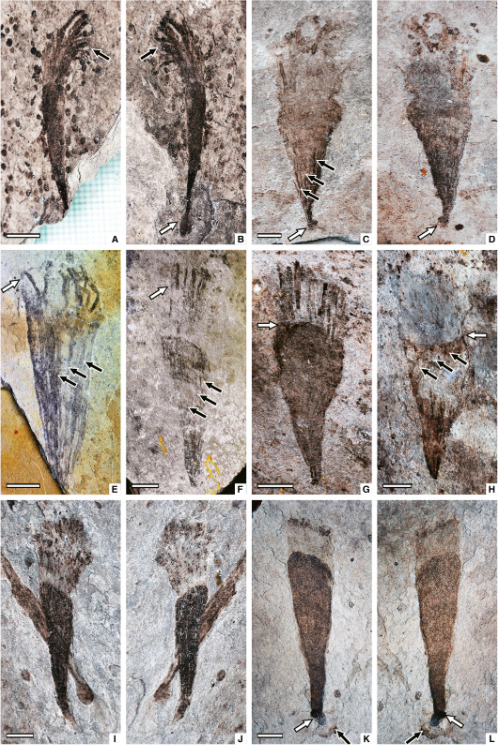
There's also the related Piyuania (left), showing a similar central structure covered in a sheath of tentacles, and their elongated cousins Qianchuania (right, A-F) and Xiuningella (right, G-I)!
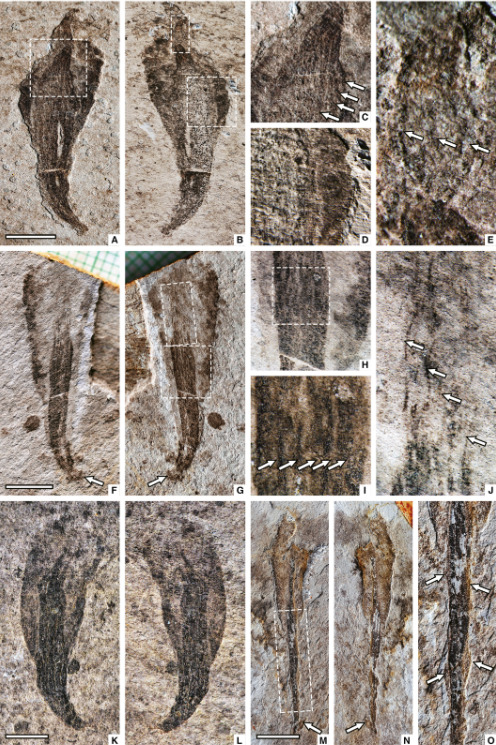
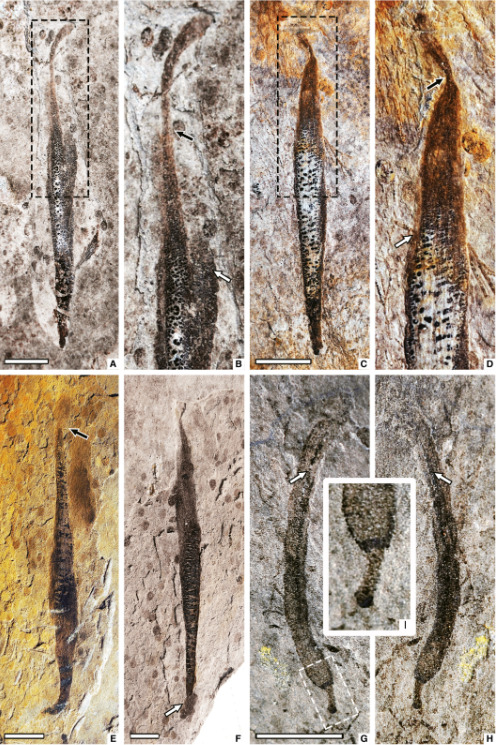
These creatures appear unrelated to lifeforms known today (except maybe cnidarians or early sessile ctenophorans?), but also to the more characteristic later Ediacaran fossils (vendobionts), making them an even more ancient mystery at the dawn of modern complex life!
https://onlinelibrary.wiley.com/doi/10.1111/pala.12242
156 notes
·
View notes
Note
PALEO MAJOR NOOOO WAY WHAT'S YOUR FAVORITE ERA
I'll be honest it's a tie between the cambrian and the cenozoic. That being said, I do quite like the ediacaran
10 notes
·
View notes
Text

You ever just make an oc based on an Ediacaran-era fossil
9 notes
·
View notes
Text
The Prehistoric Nature mod for Minecraft had an update that greatly improves the Precambrian! Now instead of a simple two-biome world where Ediacaran critters live under Cryogenian ice, there's loads of different biomes from different parts of the Precambrian to explore. Unlike the other dimensions the mod adds, the Precambrian dimension has very few actual mobile creatures going about, and all of those seem to be in the Ediacaran biomes, so it feels suitably lonely. I'll put a bunch of screenshots below the cut in whatever order I end up encountering stuff.

Neoproterozoic Microbial Plains are covered in microbial crusts, which break when you walk over them, making them quite crunchy. The little pools that dot the landscape have both red and green algae living in them.

Hadean Volcanic Wastes are suitably fucked up.

The Cryogenian naturally has both the land and sea entirely frozen over. However, underwater there's more going on than in the biomes depicting earlier eras!

Paleoproterozoic Regolith, a quite martian-looking biome showing a time before any trace of life on land.



The Ediacaran biomes are much more lively than the others, with the seas covered in Charnia and its friends, while there's even some cretures crawling around between them and jellyfish swimming. I quite like these underwater chasms running through the biome I found.

Archaean tide pools have signs of life here and there in the form of stromatolites and microbial mats. Due to the lack of oxygen, the sky ranges from red to yellow depending on the weather. There's full Archaean sea biomes to be found as well.

Mesoproterozoic Carpet has plenty of Tawuia, Grypania, and of course stromatolites.
#minecraft#prehistoric nature mod#precambrian#hadean#archaean#proterozoic#i love just exploring and looking around in this mod#it does such a good job
4 notes
·
View notes
Text
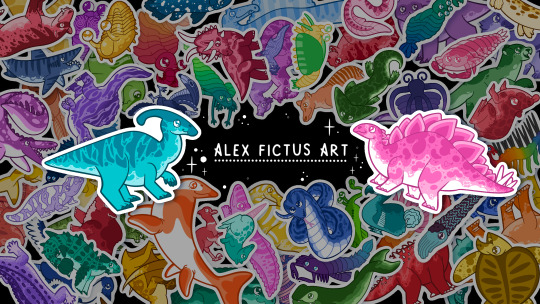
✨Paleo Party Stickers - Patch Notes 1 ✨
Added to Cambrian Era Group: Eldonia
Added to Carboniferous Era Group: Megarachne
Added to Jurassic Era Group: Hybodus, Miragaia, Chungkingosaurus, Gigantspinosaurus, Kentrosaurus, Yi Qi
Added to Cretaceous Ornithischians Group: Wuerhosaurus, Chasmosaurus, Medusaceratops, Centrosaurus, Gryphoceratops, Torosaurus, Atlascoposaurus, Shantungosaurus, Olorotian, Zalmoxes
Added to Cretaceous Saurischians Group: Siamosaurus, Ceratosuchops, Iberopsinus, Vaillabonaventrix, Sigilmassasaurus, Riparovenator, Gigantoraptor
Added to Cretaceous Non-Dinosaurs Group: Repenomamus, Sterpodon
Removed from Cretaceous Non-Dinosaurs Group: Hybodus
Added to Neogene Era Group: Chalicotherium, Deinotherium
Added to Quaternary Era Group: Gigantopithecus
Added to Holocene Era Group: Passenger Pigeon, Alligator Gar, Pelican, Horseshoe Crab, Triops
✨📈Upcoming Queue 📈✨
With pride coming up and the pride cats needing video editing, I may not hit all of these but these are my next priority groups!
Thyreophorans: Jakapil (K), Gastonia (K), Akinacephalus (K), Edmontonia (K), Tarchia (K), Gargoyleosaurus (J), Scelidosaurus (J) Sauropods: Magyarosaurus (K), Xinjiangtitan (K), Saltasaurus (K), Brontosaurus (J)
Theropods: Saurophagnax (J), Monolophosaurus (J), Metricanthosaurus (J), Albertasaurus (K), Struthiomimus (K), Incisivosaurus (K), Atrociraptor (K), Bambiraptor (K), Maip (K)
Pterosaurs: Rhamphorhynchus (J) Ediacaran: Mawsonites, Spriggina, Dickinsonia, Charnia
Paleozoic misc: Cyclida (C), Goniatites (C), Bulbasaurus (P), Diictodon (P)
Mesozoic misc: Juramaia (J), Thalattoarchon (T), Nothosaurus (T)
Cenozoic misc: Dinictis (Pg), Argentavis (N), Pelagornis (N), Toxodon (N), Nuralagus (N), Teratornis, (Qu), Platygonus (Qu), Tuatara (Living Fossil), Tanuki (Living Fossil)
This was a pretty big update! Next sticker patch notes will probably be the upload of the pride cats! If you have any recommendations or requests for the paleo party, send me a message!
All pride cats have been decided and I'm about to start printing them all for my May shop update on Friday May 3!
Date: April 2, 2024
15 notes
·
View notes